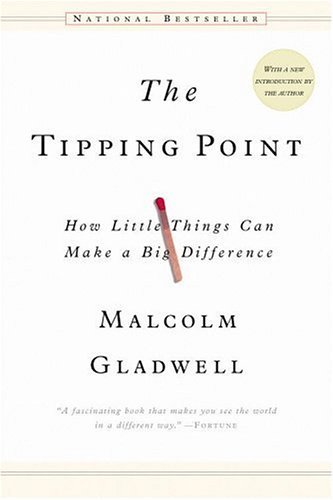The Tipping Point by Malcolm Gladwell , a Book Analysis

The Tipping Point by Malcolm Gladwell (2000) in a nutshell explains the cause of social epidemics. These epidemics are movers to effect social change or provide explanation on how certain equilibrium loses its balance and tip over. Gladwell provides answers and explanation how these tipping points affect people and how institutions are maximizing and capitalizing on these breakdowns in the equilibrium to their advantage. These tipping points could be analyzed based on three agents of change—“And when an epidemic tops, when it is jolted out of equilibrium, it tips because something has happened, some change has occurred …These there agents of change I call the Law of the Few, the Stickiness Factor, and the Power of context” (pp. 18-19). By identifying and understanding the three agents of change, the causes of tipping point and its dynamics are better explain and understood.
The Law of the Few
The law of the few works base on the premise of the 80/20 principle. It suggests that it takes only 20 percent of participants to get an 80 percent work output. This means that it only takes a few agitators, a number of radical thinkers, and a handful of contributor to upset the equilibrium, make it off balance, and create a tipping point.
For case in point, Baltimore’ syphilis epidemic. It took only a handful of people to spread the disease and create an outbreak. This is a classic example to prove Gladwell’s point that it only takes a handful of people, people that matter more than others, in creating change—“ in any given process or system some people matter more than others” (p.19). He further strengthens this point with the use of the Baltimore Syphilis spread of 1995; wherein a handful of syphilis carriers managed to create a wide-spread epidemic that affected the whole of Baltimore. It was theorized that the crack users have caused deviant sexual behavior and started spreading syphilis. While another theory suggests that it was the breakdown of the housing projects which house most of the syphilis carriers and introduced them to different neighborhoods around Baltimore that caused the wide-spread epidemic (pp. 15-17). In Whichever theory, Gladwell proved that it was these 20 percent (or much less) who carries syphilis that caused the outbreak. The people that matters most in this process are the handful of carriers which affected the delicate balance of the health system of the whole of Baltimore and caused a wide-spread anxiety and panic with regards to the 1995 syphilis outbreak.


The Stickiness Factor
The stickiness factor examines how, with the use of psychology, producers of television programs for children created an immense following. It uses an approach that “sticks” to the psyche of the kids and cause them to be attracted to such programs as Blue’s Clues and Sesame Street.
Before and during the proliferation of television, most people believed, backed by science, that television holds no relevant significance when it comes to educating children. This assumption was based on the passive nature that audiences—or children for that matter holds when watching television. Joan Gantz Cooney, was motivated to change this perception. She envisioned a television program that elicit interaction from children—a more dynamic approach rather than just watching television. With the aid of hired child psychologists and couple of technology experts, she was able to develop Sesame Street. Cooney was motivated by the desire to bridge the educational gap between the disadvantaged children and those who belong to the upper class children (pp. 89-132).
Sesame Street has such a very “sticky” effect that other producers began exploring a more interactive approach in creating children’s show. It also revolutionized how people perceive television in the sense that there is a change of mind setting on how we view the effects of television.
The Power of Context
The power of context views that the agents of change motivates their action based on the given setting or context. Gladwell explains in detail this factor through two examples (chapter 4 & 5)—the Bernie Goetz and New York Crime Rate and the popularity of Rebecca Wells’ book: Divine Secrets of the Ya-Ya Sisterhood.
Rebecca Wells’ book became a bestseller via changing its format from a hard book format to paperback, it appealed to book clubs and was able to launched an idea to reality.What made it appealing is that the format provided the way for it to land on book clubs. Book clubs are oriented based on close-knit social ties of those who belong to the group. The influence of this group created a wave because the context on which the plot is derived is realistic enough that it sells through its mass appeal. Bernie Goetz example was based on an incident on a subway wherein a handful of men tried to mug him. He retaliated by shooting at the men. On the context—time and setting to which the incident happen, Goetz was praised for what he did. Goetz acted based on the social context of that time—high crime rate means high percent of victims. By retaliating to his attackers, he was able to tip the social equilibrium from victims as frightened and abused by attackers to people who could protect themselves (pp. 133-168).
Through the three agents of change—Law of the Few, the Stickiness Factor, and the Power of context, Gladwell was able to explain in detail the movers and causes of social epidemic and how these processes gets to affect the collective.











